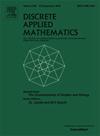一个无限族的正常的5边可着色叠加的缠结
IF 1
3区 数学
Q3 MATHEMATICS, APPLIED
引用次数: 0
摘要
设G是一个三次图。对于G的正当边着色π,如果与e的顶点相关的所有边的颜色数为3或5,则边e∈e (G)为正态边。G的正规k边着色是具有k种颜色的适当边着色,使得G的每条边都是正规的。G的正色指数,用χN ' (G)表示,是使G允许正k边着色的最小整数k。Jaeger猜想对于每一个无桥三次图G, χN ' (G)≤5,并证明了这个猜想等价于Petersen着色猜想。对于广义的Blanuša snarks、Goldberg snarks、flower snarks和Loupekhine snarks,我们已经验证了正常的5边着色猜想。Sedlar等人证明了这一猜想适用于两个重叠的snks族。本文给出了一个正色指数等于5的叠加结点的构造,给出了结点大族的正5边着色猜想。本文章由计算机程序翻译,如有差异,请以英文原文为准。
An infinite family of normal 5-edge colorable superpositioned snarks
Let be a cubic graph. For a proper edge coloring of , an edge is normal if the number of colors of all edges incident to endvertices of is 3 or 5. A normal -edge coloring of is a proper edge coloring with colors such that each edge of is normal. The normal chromatic index of , denoted by , is the smallest integer such that admits a normal -edge coloring. Jaeger conjectured that for every bridgeless cubic graph , and he also proved that this conjecture is equivalent to the Petersen coloring conjecture. The normal 5-edge coloring conjecture has been verified for some families of snarks, such as, generalized Blanuša snarks, Goldberg snarks, flower snarks and Loupekhine snarks. Sedlar et al. proved that this conjecture holds for two families of superpositioned snarks. In this paper, we present a construction of superpositioned snarks whose normal chromatic indices equal to 5, which implies the normal 5-edge coloring conjecture for large families of snarks.
求助全文
通过发布文献求助,成功后即可免费获取论文全文。
去求助
来源期刊

Discrete Applied Mathematics
数学-应用数学
CiteScore
2.30
自引率
9.10%
发文量
422
审稿时长
4.5 months
期刊介绍:
The aim of Discrete Applied Mathematics is to bring together research papers in different areas of algorithmic and applicable discrete mathematics as well as applications of combinatorial mathematics to informatics and various areas of science and technology. Contributions presented to the journal can be research papers, short notes, surveys, and possibly research problems. The "Communications" section will be devoted to the fastest possible publication of recent research results that are checked and recommended for publication by a member of the Editorial Board. The journal will also publish a limited number of book announcements as well as proceedings of conferences. These proceedings will be fully refereed and adhere to the normal standards of the journal.
Potential authors are advised to view the journal and the open calls-for-papers of special issues before submitting their manuscripts. Only high-quality, original work that is within the scope of the journal or the targeted special issue will be considered.
 求助内容:
求助内容: 应助结果提醒方式:
应助结果提醒方式:


